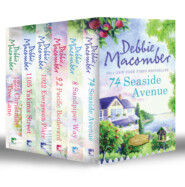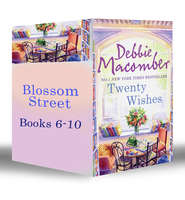По всем вопросам обращайтесь на: info@litportal.ru
(©) 2003-2025.
✖
Blossom Street
Автор
Год написания книги
2019
Настройки чтения
Размер шрифта
Высота строк
Поля
the lives of so many
1
CHAPTER
“Making a sock by hand creates a connection to history; we are offered a glimpse into the lives of knitters who made socks using the same skills and techniques we continue to use today.”
—Nancy Bush, author of Folk Socks (1994), Folk Knitting in Estonia (1999) and Knitting on the Road, Socks for the Traveling Knitter (2001), all published by Interweave Press.
LYDIA HOFFMAN
Knitting saved my life. It saw me through two lengthy bouts of cancer, a particularly terrifying kind that formed tumors inside my brain and tormented me with indescribable headaches. I experienced pain I could never have imagined before. Cancer destroyed my teen years and my twenties, but I was determined to survive.
I’d just turned sixteen the first time I was diagnosed, and I learned to knit while undergoing chemotherapy. A woman with breast cancer, who had the chemo chair next to mine, used to knit and she’s the one who taught me. The chemo was dreadful—not quite as bad as the headaches, but close. Because of knitting, I was able to endure those endless hours of weakness and severe nausea. With two needles and a skein of yarn, I felt I could face whatever I had to. My hair fell out in clumps, but I could weave yarn around a needle and create a stitch; I could follow a pattern and finish a project. I couldn’t hold down more than a few bites at a time, but I could knit. I clung to that small sense of accomplishment, treasured it.
Knitting was my salvation—knitting and my father. He lent me the emotional strength to make it through the last bout. I survived but, sadly, Dad didn’t. Ironic, isn’t it? I lived, but my cancer killed my father.
The death certificate states that he died of a massive heart attack, but I believe otherwise. When the cancer returned, it devastated him even more than me. Mom has never been able to deal with sickness, so the brunt of my care fell to my father. It was Dad who got me through chemotherapy, Dad who argued with the doctors and fought for the very best medical care—Dad who lent me the will to live. Consumed by my own desperate struggle for life, I didn’t realize how dear a price my father paid for my recovery. By the time I was officially in remission, Dad’s heart simply gave out on him.
After he died, I knew I had to make a choice about what I should do with the rest of my life. I wanted to honor my father in whatever I chose, and that meant I was prepared to take risks. I, Lydia Anne Hoffman, resolved to leave my mark on the world. In retrospect, that sounds rather melodramatic, but a year ago it was exactly how I felt. What, you might ask, did I do that was so life-changing and profound?
I opened a yarn store on Blossom Street in Seattle. That probably won’t seem earth-shattering to anyone else, but for me, it was a leap of faith equal to Noah’s building the ark without a rain cloud in sight. I had an inheritance from my grandparents and gambled every cent on starting my own business. Me, who’s never held down a job for more than a few weeks. Me, who knew next to nothing about finances, profit-and-loss statements or business plans. I sank every dime I had into what I did know, and that was yarn and knitters.
Naturally, I ran into a few problems. At the time, Blossom Street was undergoing a major renovation—in fact, the architect’s wife, Jacqueline Donovan, was one of the women in my first knitting class. Jacqueline, Carol and Alix, my original students, remain three of my closest friends to this day. Last summer, when I opened A Good Yarn, the street was closed to traffic. Anyone who managed to find her way to my store then had to put up with constant dust and noise. I refused to let the mess and inconvenience hamper my enthusiasm, and fortunately that was how my clientele felt, too. I was convinced I could make this work.
I didn’t get the support you might expect from my family. Mom, bless her, tried to be encouraging, but she was in shock after losing Dad. She still is. Most days, she wanders hopelessly around in a fog of grief and loss. When I mentioned my plan, she didn’t discourage me, but she didn’t cheer me on, either. To the best of my memory, she said, “Sure, honey, go ahead, if you think you should.” From my mother, this was as rousing an endorsement as I could hope to receive.
My older sister, Margaret, on the other hand, had no qualms about drowning me in tales of doom and gloom. The day I opened my store, she marched in with a spate of dire forecasts. The economy was down, she told me; people were hanging on to their money. I’d be lucky to stay afloat for six weeks. Ten minutes of listening to her ominous predictions, and I was ready to rip up the lease and close my door—until I reminded myself that this was my first official day on the job and I had yet to sell a single skein of yarn.
As you might’ve guessed, Margaret and I have a complicated relationship. Don’t get me wrong; I love my sister. Until the cancer struck, we were like any other sisters with the normal ups and downs in our relationship. After I was initially diagnosed with brain cancer, she was wonderful. I remember she brought me a stuffed teddy bear to take to the hospital with me. I still have it somewhere if Whiskers hasn’t gotten hold of it. Whiskers is my cat and he tends to shred anything with a fuzzy surface.
It was when I went through the second bout of cancer that Margaret’s attitude changed noticeably. She acted as if I wanted to be sick, as if I was so hungry for attention that I’d brought this horror on myself. When I took my first struggling steps toward independence, I’d hoped she’d support my efforts. Instead, all I got was discouragement. But over time, that changed and eventually all my hard work won her over.
Margaret, to put it mildly, isn’t the warm, spontaneous type. I didn’t understand how much she cared about me until I had a third cancer scare just a few months after I opened A Good Yarn. Scare doesn’t come close to describing my feelings when Dr. Wilson ordered those frightening, familiar tests. It was as if my entire world had come to a sudden halt. The truth is, I don’t think I could’ve endured the struggle yet again. I’d already decided that if the cancer had returned, I would refuse treatment. I didn’t want to die, but once you’ve lived with the threat of death, it loses its potency.
My come-what-may attitude disturbed Margaret, who wouldn’t accept my fatalism. Talk of death unsettled her, the way it does most people, but when you’ve been around death and dying as much as I have, it seems as natural as turning off the lights. I don’t look forward to dying, but I’m not afraid of it either. Thankfully, the tests came back negative and I’m thriving, right along with my yarn store. I mention it now because it was during those weeks that I discovered how deeply my sister loves me. In the last seventeen years, I’ve only seen her cry twice—when Dad died and when Dr. Wilson gave me a clean bill of health.
Once I returned to work full-time, Margaret bullied and cajoled me into contacting Brad Goetz again. Brad, who drives the UPS truck that makes deliveries to A Good Yarn, is the man I’d started seeing last year. He’s divorced and has custody of his eight-year-old son, Cody. It would be an understatement to say Brad is good-looking; the fact is, he’s drop-dead gorgeous. The first day he came into the store, wheeling several cartons of yarn, it was all I could do to keep the drool from dripping down my chin. I got so flustered I could hardly sign for the delivery. He asked me out three times before I finally agreed to meet him for drinks. Given my experience with male-female relationships, I was sure I’d be completely out of my element dating Brad. I would never have found the courage to say yes if not for Margaret, who harassed me into it.
I always say that A Good Yarn is my affirmation of life, but according to my sister I was afraid of life. Afraid to really live, to venture outside the tiny comfortable world I’d created inside my yarn store. She was right and I knew it, but still I resisted. It’d been so many years since I’d spent any amount of time with a man other than my father or my physician that I had the social finesse of a dandelion. But Margaret wouldn’t listen to a single excuse, and soon Brad and I were having drinks together, followed by dinners, picnics with Cody and ball games. I’ve come to love Brad’s son as much as I do my two nieces, Julia and Hailey.
These days Brad and I see quite a bit of each other. During my cancer scare, I’d pushed him away, which was a mistake as Margaret frequently pointed out. Brad forgave me, though, and we resumed out relationship. We’re cautious—okay, I’m the one who’s taking things slow, but Brad’s fine with that. He was burned once when his ex-wife walked out, claiming she needed to “find herself.” There’s Cody to consider, too. The boy has a close relationship with Brad, and while Cody loves me too, I don’t want to disrupt that special bond between father and son. So far, everything is going well, and we’re talking more and more about a future together. Brad and Cody are so much a part of my life now that I couldn’t imagine being without them.
Although it took her a while, Margaret is finally in favor of my yarn store. After a shaky start, my sister is a believer. She’s actually working with me now. That’s right, the two of us side by side, and that’s nothing short of a miracle. Occasionally we regress, but we’re making strides. I’m so glad she’s with me, in every sense of the word.
Before I get too carried away, I want to tell you about my shop. The minute I laid eyes on this place I saw its potential. Despite the construction mess, the temporary drawbacks and shifting neighborhood, I realized it was perfect. I was ready to sign the lease before I’d even walked inside. I loved the large display windows, which look out onto the street. Whiskers sleeps there most days, curled up among the skeins and balls of yarn. The flower boxes immediately reminded me of my father’s first bicycle shop, and it was almost as if my dad was giving my venture his nod of approval. The colorful but dusty striped awning sealed the deal in my mind. I knew this old-fashioned little shop could become the welcoming place I’d envisioned—and it has.
The renovation on Blossom Street is almost complete. The bank building has been transformed into ultraexpensive condos and the video store next to it is now a French-style café, cleverly called The French Café. Alix Townsend, who took my very first beginners’ knitting class, worked at the old video store, and it’s somehow fitting that her first real job as a pastry chef is in exactly the same location. Unfortunately, Annie’s Café down the street is closed and vacant, but the space won’t be empty for long. This is a thriving neighborhood.
The bell above my door chimed as Margaret stepped inside. It was the first Tuesday morning in June, and a lovely day. Summer would be arriving any time now in the Pacific Northwest.
“Good morning,” I greeted her, turning from the small coffeemaker I keep in the back room that’s officially my office.
She didn’t answer me right away and when she did it was more of a grumble than an actual response. Knowing my sister and her moods, I decided to bide my time. If she’d had an argument with one of her daughters or with her husband, she’d tell me eventually.
“I’ve got a pot of coffee on,” I announced as Margaret walked into the back room and locked up her purse.
Without commenting, my sister pulled a freshly washed cup from the tray and reached for the pot. The drip continued, sizzling against the hot plate, but she didn’t appear to notice.
Finally I couldn’t stand it any longer and my resolve to give her a chance to get over her bad mood disappeared. “What’s wrong with you?” I demanded. I have to admit I felt impatient; lately, she’s brought her surly moods to work a little too often.
Facing me, Margaret managed a tentative smile. “Nothing … sorry. It’s just that this feels a whole lot like a Monday.”
Because the shop is closed on Mondays, Tuesday is our first workday of the week. I frowned at her, trying to figure out what the real problem was. But she’d assumed a perfectly blank expression, telling me nothing.
My sister is a striking woman with wide shoulders and thick, dark hair. She’s tall and lean, but solid. She still looks like the athlete she used to be. I wish she’d do something different with her hair, though. She wears the same style she did in high school, parted in the middle and stick-straight until it hits her shoulders, where it obediently turns under, as if she’s tortured it with a curling iron. That was certainly part of her teenage regimen—the curling iron, the hair spray, the vigorously wielded brush. The style’s classic and it suits her, I suppose, but I’d give anything to see her try something new.
“I’m going to post a new class,” I said, changing the subject abruptly, hoping to draw her out of her dour mood.
“In what?”
Ah, interest. That was a good sign. For the most part, all the classes I’d held had gone well. I’d taught a beginners’ class, an intermediate and a Fair Isle, but there was one I’d been thinking of offering for a while.
“It’s such a difficult question?”
My sister’s sarcasm shook me from my brief reverie. “Socks,” I told her. “I’m going to offer a class on knitting socks.”
With the inventive new sock yarns on the market, socks were the current knitting rage. I carried a number of the European brands and loved the variety. My customers did, too. Some of the new yarns were designed to create an intricate pattern when knitted. I found it amazing to view a finished pair of socks, knowing the design had been formed by the yarn itself and not the knitter.
“Fine.” Margaret’s shoulders rose in a shrug. “I suppose you’re going to suggest knitting them on circular needles versus the double-pointed method,” she said casually.
“Of course.” I preferred using two circular needles.
Margaret would rather crochet and while she can knit, she doesn’t often. “There seems to be a lot of interest in socks lately, doesn’t there?” Her tone was still casual, almost indifferent.
I regarded my sister closely. She always had a list of three or four reasons any idea of mine wouldn’t work. It had become practically a game with us. I’d make some suggestion and she’d instantly tell me why it was bound to fail. I missed having the opportunity to state my case.
“So you think a sock class would appeal to our customers?” I couldn’t help asking. Good grief, there had to be something drastically wrong with Margaret.
Personally, I was fond of knitting socks for reasons beyond the current popularity. The biggest attraction for me was the fact that a pair of socks was a small project. After finishing an afghan or a Fair Isle sweater, I usually wanted a project I knew I could complete quickly. After knitting for endless hours, I found it gratifying to watch a sock take shape almost immediately. Socks didn’t require a major commitment of either time or yarn and made wonderful gifts. Yes, socks were definitely my choice for this new class. Because Tuesday seemed to be my slowest business day, it made sense to hold the sessions then.
Margaret nodded in answer to my question. “I think a sock class would definitely attract knitters,” she murmured.
I stared at my sister and, for an instant, thought I saw the sheen of tears in her eyes. I stared harder. As I mentioned earlier, Margaret rarely cries. “Are you feeling okay?” I asked, just in case, keeping my voice gentle. I didn’t want to pry, but if something really was wrong, she needed to know I was concerned about her.
“Stop asking me that,” she snapped.
I sighed with relief. The old Margaret was back.











